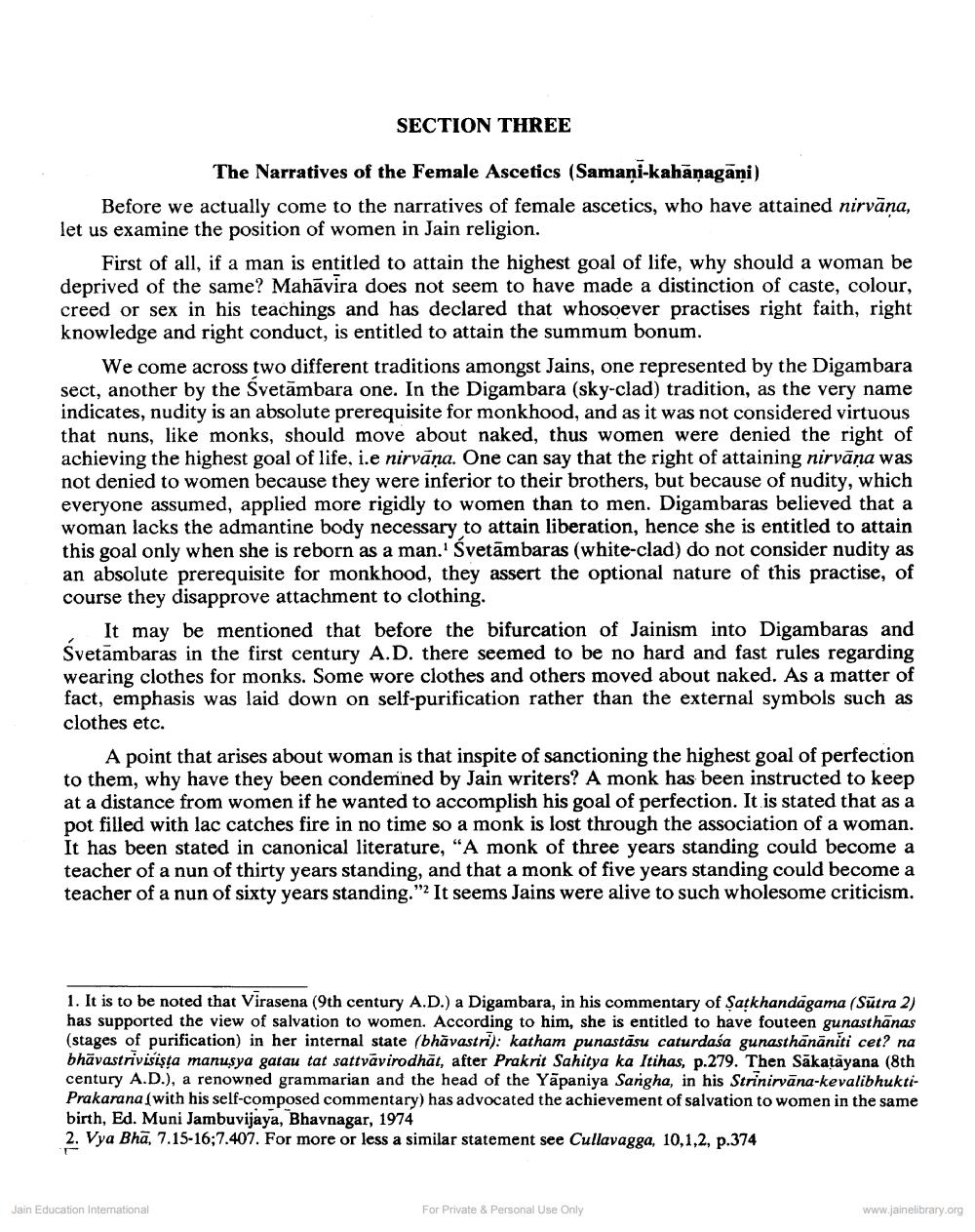________________
SECTION THREE
The Narratives of the Female Ascetics (Samaņi-kahäņagāni) Before we actually come to the narratives of female ascetics, who have attained nirvāna, let us examine the position of women in Jain religion.
First of all, if a man is entitled to attain the highest goal of life, why should a woman be deprived of the same? Mahāvira does not seem to have made a distinction of caste, colour, creed or sex in his teachings and has declared that whosoever practises right faith, right knowledge and right conduct, is entitled to attain the summum bonum.
We come across two different traditions amongst Jains, one represented by the Digambara sect, another by the Svetāmbara one. In the Digambara (sky-clad) tradition, as the very name indicates, nudity is an absolute prerequisite for monkhood, and as it was not considered virtuous that nuns, like monks, should move about naked, thus women were denied the right of achieving the highest goal of life, i.e nirvāņa. One can say that the right of attaining nirvāna was not denied to women because they were inferior to their brothers, but because of nudity, which everyone assumed, applied more rigidly to women than to men. Digambaras believed that a woman lacks the admantine body necessary to attain liberation, hence she is entitled to attain this goal only when she is reborn as a man.' Svetāmbaras (white-clad) do not consider nudity as an absolute prerequisite for monkhood, they assert the optional nature of this practise, of course they disapprove attachment to clothing.
It may be mentioned that before the bifurcation of Jainism into Digambaras and Svetāmbaras in the first century A.D. there seemed to be no hard and fast rules regarding wearing clothes for monks. Some wore clothes and others moved about naked. As a matter of fact, emphasis was laid down on self-purification rather than the external symbols such as clothes etc.
A point that arises about woman is that inspite of sanctioning the highest goal of perfection to them, why have they been condemned by Jain writers? A monk has been instructed to keep at a distance from women if he wanted to accomplish his goal of perfection. It is stated that as a pot filled with lac catches fire in no time so a monk is lost through the association of a woman. It has been stated in canonical literature, “A monk of three years standing could become a teacher of a nun of thirty years standing, and that a monk of five years standing could become a teacher of a nun of sixty years standing." It seems Jains were alive to such wholesome criticism.
1. It is to be noted that Virasena (9th century A.D.) a Digambara, in his commentary of Satkhandagama (Sūtra 2) has supported the view of salvation to women. According to him, she is entitled to have fouteen gunasthanas (stages of purification) in her internal state (bhāvastri): katham punastāsu caturdaśa gunasthānāniti cet? na bhāvastrivisista manusya gatau tat sattvāvirodhāt, after Prakrit Sahitya ka Itihas, p.279. Then Sākatāyana (8th century A.D.), a renowned grammarian and the head of the Yāpaniya Sangha, in his Strinirvana-kevalibhuktiPrakarana (with his self-composed commentary) has advocated the achievement of salvation to women in the same birth, Ed. Muni Jambuvijaya, Bhavnagar, 1974 2. Vya Bhā, 7.15-16;7.407. For more or less a similar statement see Cullavagga, 10,1,2, p.374
Jain Education International
For Private & Personal Use Only
www.jainelibrary.org




